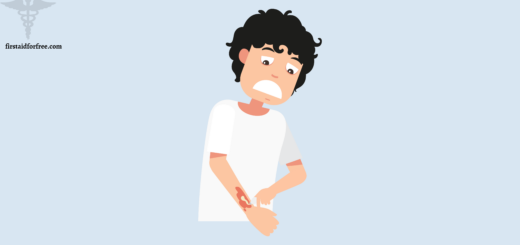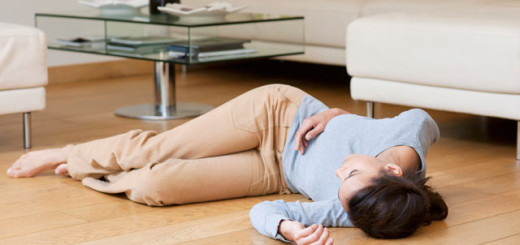4 Types of Bandages in First Aid with Their Uses
Ever bumped your knee on the coffee table or gotten a paper cut while reading the morning news?
Minor injuries are a common part of life.
You should know there’s a simple solution in your first-aid kit for these: bandages!
This blog will help you understand the different types of bandages and their uses. From now on, you won’t have to stare at a box of bandages, wondering which one to use.
Read this article to learn more!
Essential Bandage Materials
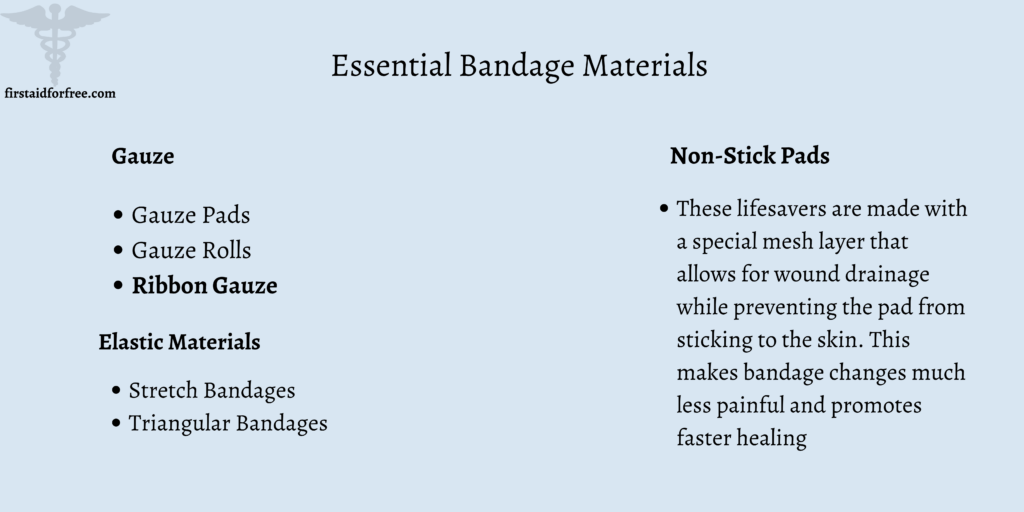
Just like a delicious recipe needs the right ingredients, proper wound care relies on specific materials to create effective bandages.
Gauze
This breathable fabric made from woven cotton comes in different thicknesses and forms:
- Gauze Pads: Square-shaped pieces used for direct wound contact. They absorb blood and other fluids and keep the wound clean.
- Gauze Rolls: Long strips of gauze ideal for securing dressings or applying pressure to control bleeding.
- Ribbon Gauze: Narrow strips often used for securing splints or smaller wounds on fingers or toes.
Elastic Materials
These come in handy for providing support and compression:
- Stretch Bandages: These are stretchy versions of roller bandages, often made from a blend of cotton and elastic fibers. They conform well to body contours and offer gentle compression for sprains or strains.
- Triangular Bandages: Though not inherently elastic, some triangular bandages are made from a blend of cotton and elastic materials, making them more adaptable for slings and splinting.
Non-Stick Pads
These lifesavers are made with a special mesh layer that allows for wound drainage while preventing the pad from sticking to the skin. This makes bandage changes much less painful and promotes faster healing.
Essential Bandaging Techniques
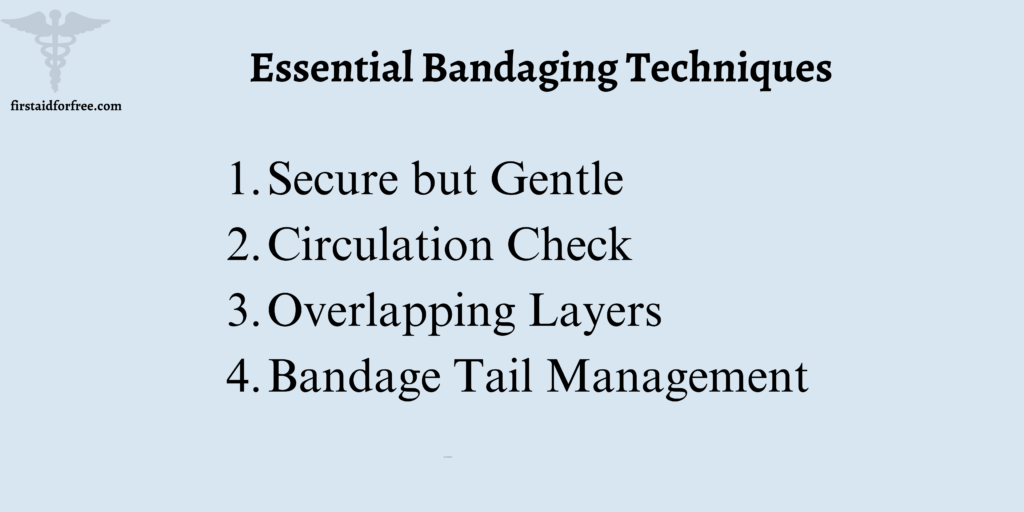
Bandages are more than just strips of cloth; they’re tools for promoting healing and preventing further injury. To get the most out of them, proper application is key.
- Secure but Gentle: The goal is to create a snug fit that holds the dressing in place without restricting circulation. Avoid wrapping too tightly, as this can cause numbness, tingling, or even cut off blood flow. You should be able to comfortably slip a finger under the bandage.
- Circulation Check: Especially after applying a bandage to an arm or leg, it’s crucial to check circulation. Look for signs like:
- The fingers or toes should appear pink or pinkish-red, not pale or blue.
- The bandaged area should feel warm to the touch, not cold.
- The person should be able to wiggle their fingers or toes freely. If you can feel a pulse below the bandage, that’s a good sign.
- Overlapping Layers: When using roller bandages, aim for smooth, even layers that overlap by about two-thirds. This ensures complete coverage and prevents gaps that could allow dirt or bacteria in.
- Bandage Tail Management: Don’t let the loose end of the bandage become a hazard! Tuck it securely under the previous layers or fasten it with tape or safety pins.
4 Common Types of Bandages and Their Uses
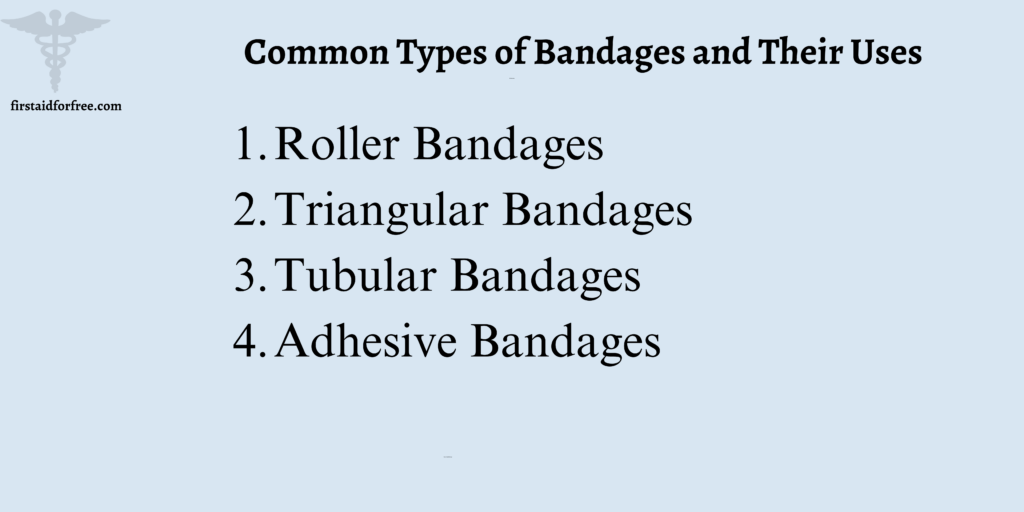
When it comes to first aid, having the right bandage for the job makes all the difference. Some common types and their uses:
1. Roller Bandages
Imagine a long, stretchy piece of gauze or elastic material. That’s a roller bandage! They offer a variety of uses:
- Holding Dressings: Roller bandages are fantastic for securing gauze pads or other dressings directly over a wound. They keep everything in place and protect the wound from further contamination.
- Applying Pressure: For minor bleeding wounds, roller bandages can be used to apply gentle but firm pressure. This helps control bleeding and promotes clotting.
- Compression Support: Sprains and strains often benefit from compression. Roller bandages can be wrapped snugly around an injured joint to reduce swelling and provide support for healing.
2. Triangular Bandages
A large piece of cloth cut into a triangle, that’s a triangular bandage. Don’t underestimate its versatility!
- Slings: A folded triangular bandage can create a comfortable sling to support an injured arm. This helps prevent further movement and promotes healing.
- Immobilization: In case of suspected fractures, a triangular bandage can be used for temporary splinting to immobilize the area until medical help arrives.
- Pressure Dressings: Similar to roller bandages, triangular bandages can be used to apply pressure to control bleeding from larger wounds.
- Make-Shift Tourniquet: In a dire situation with severe bleeding, a triangular bandage can be used as a last resort to create a makeshift tourniquet. However, this is a serious procedure and should only be attempted if absolutely necessary. It’s crucial to seek medical attention immediately after applying a tourniquet.
3. Tubular Bandages
These come in different sizes to fit various limbs and offer some distinct advantages:
- Compression and Support: Tubular bandages excel at providing gentle but firm compression to sprained, strained, or swollen areas. This helps reduce pain, swelling, and promotes healing.
- Dressing Retention: For wounds on arms or legs, tubular bandages can be used to hold dressings securely in place. They’re comfortable to wear and easy to adjust.
4. Adhesive Bandages
These lifesavers are perfect for minor cuts, scrapes, or wounds. They consist of a self-adhesive pad with a gauze or fabric backing:
- Minor Wound Protection: Adhesive bandages are ideal for covering minor injuries and keeping them protected from dirt and infection. They’re convenient and easy to apply, making them a first-aid kit staple.
Choosing the Right Bandage for the Injury
Knowing which one to use for a specific injury is necessary.
- Minor Cuts and Scrapes: For these, adhesive bandages are your go-to choice. They’re easy to apply, protect the wound from dirt and infection, and come in various sizes to fit different cuts.
- Bleeding Wounds: The goal is to stop the bleeding and keep the wound clean. Roller bandages come into play. Use them to create a pressure dressing.
- Sprains and Strains: These involve pain in muscles, ligaments, or tendons. Use roller bandages or tubular bandages. Use these to provide compression to the injured area. Compression helps reduce swelling and pain.
- Fractures: A suspected fracture requires immobilization to prevent further movement and potential damage. Triangular bandages can be used for temporary splinting until medical help arrives. Remember, splinting is a more complex procedure, so it’s always best to seek professional medical attention if you’re unsure.
FAQs
My bandage feels too tight. What should I do?
A bandage should be snug but comfortable, allowing you to slip a finger underneath. If it feels too tight, it can restrict circulation and cause numbness, tingling, or even pain. Loosen the bandage slightly and rewrap it with even tension.
Can I reuse bandages?
In general, it’s best not to reuse bandages. They are designed for single use and become less sterile with each use.
Reusing a bandage increases the risk of infection.
What should I do if a bandage gets wet?
A wet bandage loses its effectiveness in protecting a wound and can promote bacterial growth. If an adhesive bandage gets wet, remove it and replace it with a dry one. For a larger bandage like a roller bandage, if only a small part gets wet, you might be able to carefully dry that section and re-wrap the bandage.
Conclusion
With this newfound knowledge of bandages, you’re well on your way to becoming a first-aid pro. Stock your first-aid kit with a variety of bandages and practice your bandaging techniques. With a little preparation and the right tools, you can confidently handle those everyday bumps and scrapes.
Remember, bandages are for minor injuries, but for anything serious, seeking professional medical attention is always the best course of action.


